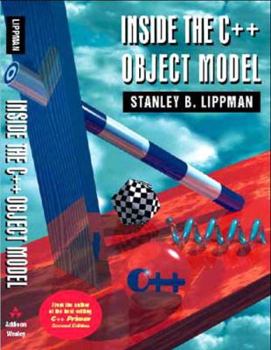Inside the C++ Object Model
Select Format
Select Condition 
Book Overview
Bestselling author Stanley B. Lippman's Inside the C++ Model provides valuable insight into some of the internal workings of the C++ language. This book is a product of a decade of research at Bell... This description may be from another edition of this product.
Format:Paperback
Language:English
ISBN:0201834545
ISBN13:9780201834543
Release Date:January 1996
Publisher:Addison-Wesley Professional
Length:304 Pages
Weight:1.06 lbs.
Dimensions:0.9" x 6.4" x 9.3"
Customer Reviews
5 ratings
Essential Reading for Real Time C++ Programmers
Published by Thriftbooks.com User , 18 years ago
If you use C++ in real time environments, you need this book. Real time programmers need to understand "what is going on under the covers." This is really the only book I've found that explains it in depth. Reading this book is important if you are trying to decide whether to code in C or C++. You need to understand the overhead of C++, where it comes from and, at times, how to avoid it. When debugging an understanding of how the compiler translates C++ code into machine language is essential. Lippmans book does not delve into code generation but it does provide a framework for understanding how the C++ object model is represented in machine language. I'll be the first to admit that Lippman can go off on to some arcane tangents. He can spend a few pages discussing details that really have minimal effect on code execution. But I'm willing to forgive these diversions because so much of his book has contributed to my understanding of C++ and how it works.
5 stars not enough...
Published by Thriftbooks.com User , 18 years ago
I have thought that I had enough knowledge of C++, but after reading this book, I know I was wrong. Detailed discussion of constructor, data member, virtual table, multiple inheritance etc, there are a lot of mysterious details in C++ covered in this book. Yet this book is only 280 pages, which means there are very few redundant words seen in a lot of other tech books. Recommend reading it with a compiler. I use Visual C to compile sample code and generate the asm file to see the real code compiler generates. It is rewarding.
Great for any serious C++ user
Published by Thriftbooks.com User , 21 years ago
If you have been using C++ for a while now, and you REALLY want to know what is going on under the hood, read this book - and gain and again until you have memorized it. As a software architect, I use this book almost on a daily basis - most of the time to prove my case and to show what is really going on behind my design decisions. The benchmarks are useful as they really show you what the difference between C, C++ is with various compilers. I have referred to those benchmarks more times than I can remember.
Excellent
Published by Thriftbooks.com User , 23 years ago
...truly excellent. If you are seeking to truly UNDERSTAND C++, not just increase your familiarity with the syntax, INSIDE THE C++ OBJECT MODEL is one of the first books I would recommend reading. Stan Lippman, besides being one of the most C++ - knowledgeable humans on the planet, is an excellent writer. His style is quick, to the point, and non-repetitive (to some, this might indicate a difficult read, of course). INSIDE examines the features and additions C++ brought to the world of C - from the inside - demonstrating the creation of objects, instantiation of templates, and more through comparisons with C-based code generated by the CFRONT compiler. For the reader with a good, intermediate understanding of C++, this will be a revelation; seeing a representation of an object - its vtables and internal structure - as a construct that actually exists in memory is simultaneously enlightening and delightful. Few 1500-page texts TEACH so much as this book does in 270-odd pages. One of the best.
The next step to learning time trade offs in C++
Published by Thriftbooks.com User , 26 years ago
This book is excellent in telling the underlying implementation of C++ and how the cfront compiler changed C++ into C. While this is not an everyday task and one that most people could care less about, it is truly one of the most important things you could learn because it shows an important comparison between the code you don't have to write and the execution time you lose. Every C++ programmer should have read this book at least 10 times to decide what structures should be used under what circumstances





